Introduction
Counterfeiting has been defined as “the act of producing or selling a product containing an intentional and calculated reproduction of a genuine trademark” (McCarthy, 2004). Counterfeiting originated with the piracy of elite consumer products, such as branded clothing and accessories but now has expanded to the music, video, fertiliser, pharmaceutical industries and even to food products, such as Coffee Beans drinks. In 2011, the international trade of counterfeit goods is estimated to be worth $650 billion and is expected to increase to $1 trillion in 2015 (Frontier Economics, 2011).
Piracy has recently become a rising trend in China, Thailand, India and Malaysia, making them known as the ‘home for piracy’ due to being regarded as the world’s worst violators of intellectual property rights and worst counterfeit offenders (Haque, Khatibi, and Rahman, 2009). In a report on the “adequacy and effectiveness of U.S. trading partners’ protection of intellectual property rights (IPR)”, Malaysia was among the countries listed in a watch list and was invited to cooperate in developing action plans to resolve IPR issues of concern, amongst which is the piracy over the internet and digital piracy (United States Trade Representative, 2011). Ismail Sabri Yaakob (2011) also reported that there has been an increase in the number of counterfeit cases investigated in Malaysia as compared to the previous year which resulted in a higher value of confiscated pirated goods.
According to Trade.ec.europa (2006), Malaysian authorities are improving their efforts to battle against piracy through increased raid actions, amendments to relevant laws, allowing filing of complaints to the trade ministry, and even containment of import and export of these goods. However, Trade.ec.europa (2006) suggests that the “level of infringement remains exceptionally high and trade in counterfeit goods is generalised”. Thus, this study aims to aid the efforts in the campaign against the trading of counterfeit goods. This research paper highlights the purchase intentions of college and university students on counterfeit goods, particularly on luxury products. The results are then correlated with respondents’ level of ethics and materialism to identify the influence of these values on their intention. Hence, the findings of this study would provide the government with a better understanding on the purchase intention of this country’s educated youth with regards to luxury counterfeit goods. This will then allow them to come up with better strategies to gain the support the nation needs in the battle against counterfeit goods.
In order to accomplish the aim of this study, the following research questions were explored:
1.What is the purchase intention of students in regard to counterfeit luxury goods?
2.To what extent do students practice materialistic and ethical values, and is there a relationship between these variables?
3.Does a significant relationship exist between materialism and the purchase intention of luxury counterfeit goods among students?
4.Does a student’s ethical standards have a significant relationship with their purchase intention of luxury counterfeit goods?
Literature Review
Counterfeit Goods
Counterfeiting is classified into two categories, namely deceptive and non-deceptive counterfeiting. Deceptive counterfeiting takes place when the consumer is unaware of the fact that they have purchased a copy instead of the original product and cannot be held accountable for the behaviour. Non-deceptive counterfeiting on the other hand takes place when the consumer intentionally purchases counterfeit products (Phau & Prendergast, 1998). This research focuses on non- deceptive purchases of counterfeit products.
Previous research have shown that perception provide the grounds for purchasing decisions (Xuemei, Moutinho, 2011). Based on the research, consumers choose to purchase counterfeit branded products for several reasons. This study, like many recent works, focuses on the demand side of counterfeiting. There is an increasing number of researchers who suggest that the most crucial causes of dramatic growth of the counterfeiting industry is consumer demand (e.g. Gentry, Putrevu, Shultz, and Commuri, 2001; Chan et al.,1998). Muncaster (2011) stated that Asian countries, led by China are responsible for the majority of counterfeit goods produced. According to Lai and Zaichowsky (1999), the difference in perception between people in the West and the East was one of the reasons for the abundance of counterfeit in Asia. According to traditional Chinese tradition, a student is honoured and credited when the student successfully reproduces the work of the teacher. Similarly, in Asia, the name of a translator is placed together on the title page alongside the original author’s name. In the west however, students are encouraged to be original and not to plagiarize. This study explores undergraduates’ purchase intentions of non-deceptive counterfeit luxury goods in Malaysia. According to Ang et al. (2001), counterfeit luxury goods are reproductions of a trademark brand which are very much like genuine articles which include packaging, labelling, and trademarks intentionally to resemble the original product. In the context of this research, counterfeit luxury goods include garments, watches, handbags, and others. Consumer purchase of counterfeit luxury goods is expected to be influenced by various factors. In this study, a number of variables related to ethics and materialism are selected as key constructs influencing consumer purchase intention of counterfeit luxury goods.
Materialism
Materialism can be defined as the tendency to place more importance on material possession and physical comfort rather than spiritual values. According to Belk (1984), materialism is “the importance a consumer attaches to worldly possessions.” In the context of consumer behaviour, materialism can be conceived as consumer perception towards money and physical objects. It is associated with consumer eagerness to possess material objects. Children and senior citizens appear to be less materialistic as compared to youths and middle-aged people (Belk, 1985). Possessiveness, non-generosity, and envy are described by Belk (1984, 1985) as the three dimensions of materialistic values. Belk (1983, 1985) defines possessiveness as “consumer tendency to maintain possessions of one’s personal things”. Non-generosity is associated with consumer displeasure of sharing or donating things to others (Belk 1984, 1985). Envy refers to “one’s aversion at other people’s happiness, success, reputation, fortune, and possessions of things” (Belk, 1985). Consumption of counterfeit goods can be seen as a response to an individual’s own materialistic needs. Thus, it can be argued that those who consume counterfeit goods have a stronger tendency to be materialistic.
H1: There is a relationship between materialism and the purchase intention of luxury counterfeit goods among students.
Ethical Values
According to Neale and Fullerton (2010), ethics in itself has no universally accepted definition. However, they explained ethics as “a set of principles describing a behaviour code that explains what is good and right or bad and wrong.” Another definition provided for ethics is “how people ought to act based on moral principles and ideals such as justice, fairness and trust.” It should be noted nonetheless that both definitions assume that a consensus can be reached on how people should act (Neale et al, 2010). This on the other hand differs from what Powers and Vogel (1980) had stated where the “definition of ethics reflects social, cultural and temporal evolutions of moral principles,” therefore not bounding it to a need of a consensus. Hunt and Vitell (2006) suggest that ethics play a crucial role in decision making situations. However, individuals’ purchasing decisions depend on their degree of ethics. Some consumers prefer to be ethical in purchasing situations, while others don’t bother about the ethical concerns involved in purchasing situations.
A study conducted by Lee and Workman (2011) showed that consumers of counterfeit products exhibit minute ethical concerns as compared to non-users. In addition to this, consumers from some Asian countries do not consider buying counterfeits unethical (Ang, Cheng, Lim et al. 2001). In China, some consumers are not even aware of the legal concerns involved in purchasing the counterfeit product (Safa and Jessica, 2005). In Pakistan, consumers are ignorant about the anti-counterfeiting laws and continue to purchase counterfeit goods.
Vitell (2003, p. 33) mentioned that there is a fundamental ethical component in all forms of consumer behaviour. There have been previous studies that tried to expand the understanding of consumer ethics. Al-Khatib, Vitell and Rawwas (1997) provided four broad categories of studies on consumer ethics: authors who empirically examined very specific behaviours that have ethical implications; authors who focused on providing standardised guidelines for businesses and consumers on ethically related issues; papers focusing on development of a conceptual basis for describing ethical decision-making by consumers; and also studies attempting to empirically understand the ethical decision making of consumers.
This then led to the development of the Consumer Ethics Scale (CES) by Muncy and Vitell (1992). Using applications from Hunt and Vitell (1986), the scale was created as an effort to “investigate consumers’ beliefs about a variety of market-place practices containing ethical content,” (Kozar and Marcketti, 2011). Kozar and Marcketti (2011) then mentioned that the CES has been widely used and validated in diverse cultural settings, and amongst them were by Muncy and Eastman (1998). This study (Muncy and Eastman, 1998) was carried out to determine the relationship between consumers’ ethical standards and materialism. They discovered significant evidence supporting the relationship between the values of ethics and materialism, whereby “consumers with greater materialistic tendencies exhibited lower ethical standards as compared to less-materialistic consumers.” Kozaret al. (2011) pointed out that this contradicts past studies that deduced that “materialism, or an orientation toward possessions and money, was not related to ethical judgments or intentions.” This then sparked their interest to further explore the relationship between these two variables. Since this study was adapted from Kozaret al.’s (2011) research, it will be examining the same relationship in the Malaysian consumers’ context, specifically among the undergraduates.
H2: There is a relationship between ethics and the purchase intention of luxury counterfeit goods among students.
H3: There is a relationship between materialism and ethical values
Methodology
This study was intended to investigate the purchase intention among Malaysian undergraduates on luxury non-deceptive counterfeit products. Therefore a descriptive research was conducted through a process of collecting 200 self-administered surveys in May 2012 in order to test the hypothesis. A convenience sample was chosen among students from 8 different public and private universities within the states of Kuala Lumpur and Selangor. As counterfeit purchase intentions area is a sensitive topic, people might have been reluctant to answer the questionnaires sincerely. In order to reduce this potential concern, the respondents were notified that this research is purely for academic purposes and their names and information would remain confidential.
This study focused on determining if undergraduate students’ purchase intention of luxury counterfeit goods is affected by their ethical and materialistic values. The theoretical framework for this study had been adapted from a previous research conducted by Kozar and Marcketti (2011) which focused on researching the correlation between ethics and materialism with the consumer’s purchase intentions of luxury counterfeit goods. The research framework of this study is illustrated by Figure 1.
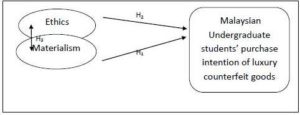
Figure 1: Theoretical Framework
Ethics and materialism of the respondents was correlated with their purchase intention of luxury counterfeit goods. A four-page questionnaire was developed which comprised of 4 sections. Scales for this study are adapted and modified from previous researches. The majority of the items used 5-point Likert scale. To measure the consumers ethical values, the Muncy-vitell scale (1992) was adapted and implemented into this study (Lau, 2010). The scales were presented to the respondents along with a set of statements which involves ethical content. For each statement the participants ethical values will be measured on a five-point scale with 1 indicating, “strongly believe that it is wrong” and 5 indicating, “strongly believe that it is not wrong” (Lau, 2010).
To evaluate the respondent’s materialistic values, Belk’s materialism scale of 1984 was adapted into the study. Belk says materialistic behavior has three main dimensions: possessiveness, non-generosity, and envy (Belk, 1984). The scale assessing the respondent’s levels of materialism used a five-point scale which encompassed the three primary components, with 1 indicating, “strongly disagree” and 5 indicating, “strongly agree” (Belk, 1984).
Purchase intention of the respondents was assessed by adapting a 5 item scale which was first developed by Spears and Singh in 2004 (Xuemei and Moutinho, 2010). Spears and Singh described purchase intention as an “individual’s conscious plan to make an effort to purchase” (Spears and Singh, 2004). The scale comprised of statements which measured the consumers purchase intentions with 1 indicating, “strongly disagree” and 5 indicating, “strongly agree” (Spears and Singh, 2004).
Standard measures will be used to compile the respondents’ demographic information, such as gender, age, ethnicity, and household income which will be included in the questionnaire.
Factor Analysis & Reliabilty of Measures
Initially, the variables within the instruments were as listed in Table 1.1. These variables were then reduced to 7 through varimax rotation in factor analysis (as seen in Table 1.2), and results for the Bartlett’s Test of Sphericity and the KMO reveal that both were significant (p<.05).
Table 1.1: Original Variables from Instruments
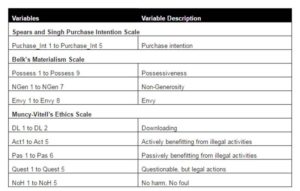
Several items and even variables from the original instruments were not included were due to low loadings (<.04) or failure of the reliability tests. The internal reliabilities of the new constructs however were found to be acceptable. Among the new items of the consumer ethics scale, the Cronbach-alpha for purchase intention is 0.900, and for the three summed variables of the ethics scale were 0.865 (P&Q),0.836 (Act), and 0.744 (NoH). The alpha for the three summed variables of the materialism scale were 0.703 (NGen), 0.654 (PhysP), and 0.669 (SentP).
Table 1.2: New Variables after Varimax Rotation in Factor Analysis and Reliability Tests
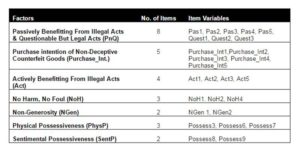
Analysis
Respondents Profile
Table 2.1: Respondents Profile with Mean Perceived Purchase Intentions of Non-Deceptive Counterfeit Goods, Ethics, and Materialism
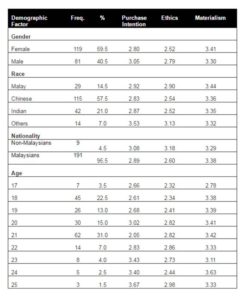
Out of the 200 available data, 59.5% were females and 40.5% were males. Respondents were university undergraduate students where the majority (31%) were 21- year- olds. It should be noted that 115 out of the 200 of the respondents were Chinese, while the Malay, Indian and other races make up the remainder of the respondents. Table 2.1 illustrates the demographic breakdown of the respondents along with their perceived purchase intentions of Non-Deceptive Counterfeit Goods (rated as 1 – strongly disagree, to 5 – strongly agree), as well as in terms of Ethics (rated as 1 – strongly believe it is wrong, to 5 – strongly believe it is not wrong) and Materialism (rated as 1 – strongly disagree, to 5 – strongly agree).
From Table 2.1, it can be seen that those who has higher purchase intentions are mostly 25- year- old males. It is also interesting to point out the fact that ‘Non-Malaysians’ and ‘Other’ races are seen to have higher purchase intentions than that of their counterparts. It can also be seen that level of materialism generally increases by age, and that at all levels respondents perceive themselves to be material and ethical.
Ethics and Materialism
In order to develop a better understanding of the respondents’ perceived values towards ethics and materialism, the means of the three summed variables of the consumer ethics scale and three of the materialism scale were reviewed (as seen in Table 2.2) were correlated. Among the means of the variables within the consumer ethics scale, it can be seen that the respondents generally have high ethical standards. For the majority of the summed variables, the mean scores were below the neutral point of 3.0 on a five-point likert scale ranging from 1 (strongly believe it is wrong) to 5 (strongly believe it is not wrong). More specifically, respondents perceive situations of whether ‘actively or passively benefitting from illegal acts’ or even ‘questionable but legal acts’ to be considered unethical. Kozar et al. (2011) interprets this as consumers believing that there is no difference on who is to blame (whether the buyer or the seller) for participating in potentially unethical behaviours. There is an exception to this however as the mean score for activities of ‘no harm, no foul’ surpassed the neutral point of 3.0. On the other hand, Vitell and Muncy (2005) agreed to this, stating that many did not perceive this act to be unethical, as Singhapakdi, Vitell, Rao, et al. (1999) explained that the overall judgements one makes is possibly affected by the “proximity” that he or she feels to the relevancy of the ethical dilemma.
Table 2.2: Descriptive Statistics of Ethics and Materialism Variables

In contrast to the findings of the ethics scale, the majority of the mean scores within the materialism subscale were above the point of 3.0 on a five-point likert scale that ranged from 1 (strongly disagree) to 5 (strongly agree). As illustrated by Table 2.2, both physical possessiveness and sentimental possessiveness had nearly similar high scores, indicating that respondents has “the inclination and tendency to retain control or ownership of one’s possessions” (Belk, 1985), whether the possessions are physical or even sentimental objects. On the other hand, respondents scored lower than a 3.0 in the dimension of non-generosity. This then shows that despite having the tendency to maintain control of their possessions, they are also willing to give or share their possessions with others. Having said that, overall it can be deduced that respondents of this study do have materialistic tendencies.To test the third hypothesis (H3), the relationship between respondents’ perceived consumer ethics and materialistic values had to be examined. This was done through a correlation analysis among the variables of the two scales that was used. The results (as seen in Table 2.3) showed that the Pearson coefficient indicated no significant relationships among the summed variables used, except for two relationships.
Table 2.3: Correlations between Ethics and Materialism Variables

Based on how they were coded, the findings of an inverse relationship between certain subscales in the variables indicated that ethical respondents in this study would likely perceive themselves as a materialistic person as well. This finding contradicts the results obtained by Kozar et al. (2011) that was supported by Muncy and Eastman (1998) where it was found that “consumers with greater materialistic tendencies exhibited lower ethical standards as compared to less-materialistic consumers.”
Purchase Intentions of Non-Deceptive Counterfeit Goods
Table 2.4: Descriptive Statistics of Purchase Intentions of Non-Deceptive Counterfeit Goods
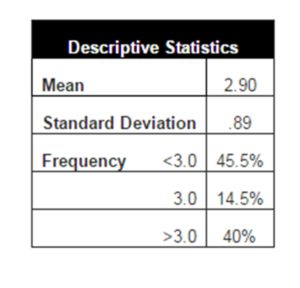
Before assessing the relationships between respondents’ purchase intention and the independent variables, a better understanding of the respondents’ purchase intentions is needed. As seen inTable 2.4, the descriptive statistics of the purchase intentions show that the majority of the respondents scored less than the 3.0 neutral point, thus indicating that the respondents disagreed on having purchasing intention in regard to non-deceptive luxury counterfeit goods.
Assessing Moderating Effect Of Income on the Relationship between Purchase Intentions vs. Ethics and Materialism
To achieve an even better understanding of respondents purchase intention of non-deceptive luxury counterfeit goods, both ethics and materialism scales are summed and tested to check if the relationship betweenthese variables and respondents’ purchase intention are associated with their average household income level. It can be seen (in Graphs 1.1 and 1.2, and Tables 2.5 and 2.6) that the effects of both materialism and ethics on purchase intention have the same relationship patterns when moderated by average household income, i.e. high levels of both ethics and materialism converge on the same purchase intention of counterfeit luxury items across all three levels of average household income groups. There is no significant slope present for average household income’s moderating effect between materialism and purchase intention (Refer to Table 2.5).The only significant moderating effect of average household income appears for the low income group when seen in its relationship between ethics and purchase intention of counterfeit luxury items (Refer to Table 2.6). It is interesting to note that the pattern for the convergence on the relationship for all three income groups starts earlier in ethics as comparedto materialism when assessing on a continuum. (as compared between graph 1.1 (Materialism) and Graph 1.2 (Ethics)).
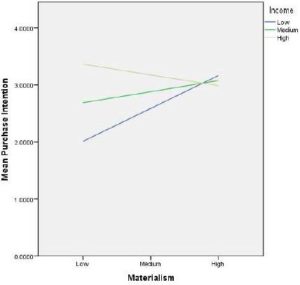
Graph 1.1: Average Household Income as a Moderating Variable in the Relationship between Materialism and Respondents’ Purchase Intention
Table 2.5: Slope Summary for Graph 4.1

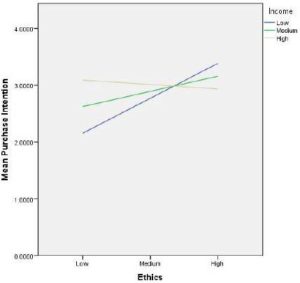
Graph 1.2: Average Household Income as a Moderating Variable in the Relationship between Ethics and Respondents’ Purchase Intention
Table 2.6: Slope Summary for Graph 4.2

Hypotheses Assessed
To assess the first hypothesis (H1), the relationship between respondents’ reported purchase intention of non-deceptive counterfeit goods and their materialistic values had to be tested. To assess whether a significant relationship existed between the two, a multiple regression analysis (MRA) was used where the purchase intention was the dependent variable, while the three computed scores of the materialism scale was set as the independent variables. As seen in Table 2.6, the R value for this model is .211, showing that a weak relationship exists between the two variables. Also, the model was found to be statistically significant as it had F-value of 3.042 (at p<.05), indicating that the model consists of at least one significant predictor, which in this case is ‘physical possessiveness’ (as at 5% level). Hence, H1 is supported as there is a significant, although weak, positive, relationship between purchase intentions and at least one of the subscales of materialism.However, unlike previous researches (Kozar et al., 2011), the relationship between these two variables have a positive relationship as respondents identify themselves as having the tendency to be materialistic while having low purchase intentions.
To test the final hypothesis (H2), a similar MRA was used to determine an existence of a significant relationship between respondents’ reported purchase intention of non-deceptive counterfeit goods and their perceived level of ethics. Also illustrated by Table 2.6, the R value of .306 for this second model indicates an almost moderate relationship between ethics and the purchase intentions. The F-value of 6.743 (at -<.05) shows that the relationship is significant and at least one of the predictors is significant. In the case of this model, the significant variable is ‘no harm, no foul’ (as at 5% level). H2 is also seen to be supported with an almost moderate significant relationship between respondents’ purchase intention of non-deceptive goods with at least one of the subscales that measured their ethical level.
In addition, a third model was created with all six computed scores of both the materialism and ethics scale set as independent variables against respondents’ purchase intentions of non-deceptive counterfeit goods. This was done to further understand the relationship between these three variables through a combination of both ethics and materialism factors into the model. A stronger R value of .372 as seen in Table 2.6 indicates a stronger influence on the dependent variable as compared to the two previous models. The R2 is also seen to be higher than that of the previous two, at .138, indicating that the combination of ethics and materialism can explain about 13.8% of the variance in the respondents’ purchase intentions. The F-value of 5.157 (as at 5% level) also indicates that the moderate relationship between ethics and materialism with purchase intentions is a significant one.
Table 2.7: Regression Results for Ethics and Materialism with Purchase Intention
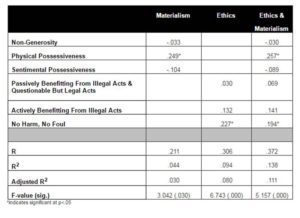
As seen in Table 2.3 above, two of the computed subscales of the consumer ethics scale (PnQ and Act) had a negatively weak, but significant (at the 0.05 level) relationship to one of the summed variables of the materialism scale (PhysP). Thus, H3 was accepted.
Discussions
This paper has identified that participants recognise both actively and passively benefitting from an illegal activity to be unethical and they are indifferent to who is to blame (whether the buyer or the seller) for participating in this act, as seen from the review of the mentioned subscales. Past studies (Vitell and Muncy, 1992; Kozar et al., 2011) had similar results, where Vitell and Muncy (1992) mentioned that despite consumers making comparison on who is to blame in a variation of situations, overall all actions in both subscales were identified as wrong. This finding was also consistent to acts that are questionable but legal, which however is in contrast to previous findings. Vitell and Muncy (2005) revealed that deceptive but legal activities are perceived to be more ethical than passively benefitting from illegal acts, which then suggests that the respondents of this study equates ‘”wrongness” as being more than just illegal.In a slightly contradicting manner, this paper had also discovered that although having high ethical standards, respondents still perceive certain arguably wrongful acts as acceptable provided that they do not harm any other party. The ‘no harm, no foul’ subscale had provided results that was consistent with previous studies where Muncy and Vitell (2005) stated that activities involving intellectual property rights to be identified as ethical.
This study had also discovered that respondents’ perceived ethical beliefs is seen to be inversely correlated with their materialistic values, contradicting to what was reported by Muncy and Eastman (1998). In contrast to what previous studiesstated where a materialistic consumer would more likely possess a lower ethical standard than those consumers who identify themselves to be less materialistic (Muncy and Eastman, 1998), the respondents of this study seem to identify themselves to be both ethical and materialistic at the same time. This however still shows support against past studies which states that there isnot any relationship between ethical and materialism values (Kozar et al, 2011) as the results of this study show a significant relationship between the two variables.
Through the examination of the subscales within the materialism scale, the respondents of this study can be identified as having a tendency to be more materialistic. This is due to the fact that two out of the three subscales were beyond the neutral point of 3.0 on a five-point likert scale. Due to scoring above neutral for the possessive subscales, both for physical and sentimental objects, respondents exhibit the tendency to have command over their belongings (Belk, 1985). Thus, this would definitely affect their purchasing behaviour.
Another one of the findings of this paper is that the constructs used showed a correlation between respondents’ purchase intention of non-deceptive counterfeit goods with their perceived ethical and materialism values. Respondents who are seen to be both highly ethical and have materialistic tendencies indicated to having less tendencies to purchase non-deceptive counterfeit goods or even the intention to purchase them for that matter.
An interesting finding also shows that there is no significant moderation effect of average household income on the relationship between materialism and purchase intention for counterfeit luxury item goods but only appeared in the low income group between ethics and purchase intention. This then resulted in the final theoretical framework for this study, illustrated by Figure 2. These findings rules out the possibility of attributing the strong inclination for purchase of luxury counterfeit items based on affluence and in fact place emphasis only on materialism and ethics.
This study shows findings that are beneficial in developing a better understanding of these variables, especially in the context of Malaysian undergraduate students. However, the results of this paper also shows that the variables ethics and materialism only explain a small portion of respondents’ purchase intentions, therefore highlighting the need for further research on the effect of additional factors on the demand for counterfeit goods in market.
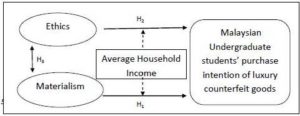
Figure 2: Final Theoretical Framework
Although overall respondents’ purchase intention on non-deceptive counterfeit goods was slanting towards a disagreement with the purchase of these goods, there were still about 40% of these students possessing those intentions. Kozar and Marcketti (2008) statedstudents’ knowledge and concern about counterfeiting is correlated with their belief towards manufacturing, distributing, and purchasing of these goods in terms of legality. Therefore, from an education stand point, students need to be exposed to the reality of counterfeiting within the classrooms, emphasizing the harm of the support of these goods towards not just the businesses involved, but also to the country’s economy. The country’s educated youth needs to be further educated on how the values the hold, especially in terms of materialism and ethics, could implicate their consumption behaviour, thus affecting their perceptions on counterfeit goods. Kozar et al. (2011) also suggested an educational campaign that targets students who are involved in unethical consumer practices to further tackle this problem.
In addition, since respondents show tendencies to be materialistic while having low intentions of purchasing non-deceptive counterfeit goods, this could indicate that they would prefer original branded goods over fake ones. This could then be exploited by allowing for a faster growth within the related industries such as fashion, thus providing Malaysian consumers more choices at better prices. Consumers would therefore have more reasons to support original goods over counterfeit one, hence reducing the demand for non-deceptive counterfeit goods.
Furthermore, the social responsibility movement in terms of consumers’ knowledge on ethical and environmentally conscious consumption practices needs to be further improved. The government and businesses need to increase their work on addressing and resolving counterfeiting problems. Every party needs to create an alliance in encouraging better ethical purchasing behaviour, especially among students who are the leaders of tomorrow.
Limitations and Future Research
Similar to any other research, this paper has its limitations. Due to the method of convenience sampling in the collection of data and a limited scope of time, data could only be collected from eight universitiesaround Kuala Lumpur and Selangor. Furthermore, since data was collected from students of universities from these two states only, thefindings of this study cannot be generalized for all undergraduate students across Malaysia. In addition, the data was collected from a sample of that predominantly consisted of Chinese respondents, thus further limiting the generalisation of the findings. Also, this research focused only on luxury non-deceptive counterfeits goods. However, to fully understand consumers’ perception and purchase intentions of counterfeit goods, it is suggested that future studies further explore a wider range of counterfeit products. This could then help in gaining a better understanding of the perception of counterfeit goods.
References
Al-Khatib, J. A., Vitell, S. J. & Rawwas, M. Y. A. (1997). “Consumer Ethics: A Cross-Cultural Investigation,” European Journal of Marketing, Vol. 31 Issue: 11 pp. 750 – 767
Publisher – Google Scholar
Ang, S. H., Cheng, P., Lim, E. A. C. & Tambyah, S. (2001). “Spot the Difference: Consumer Responses towards Counterfeits,” Journal of Consumer Marketing, 18 (3), 219-235
Publisher – Google Scholar
Belk, R. W. (1983). ‘Worldly Possessions: Issues and Criticisms,’ in Advances in Consumer Research, Vol. 10, eds. Richard P. Bagozzi and Alice M. Tybout, Ann Arbor, MI: Association for Consumer Research, 514-519.
Google Scholar
Belk, R. W. (1984). “Three Scales to Measure Constructs Related to Materialism: Reliability, Validity, and Relationships to Measures of Happiness,” in Advances in Consumer Research, Vol. 11, ed. Thomas Kinnear, Provo, UT: Association for Consumer Research, 291-297.
Publisher – Google Scholar
Belk, R. W. (1985). “Materialism: Trait Aspects of Living in the Material World,” Journal of Consumer Research, 12 (December), 265B280.
Publisher – Google Scholar
Bian, X. & Moutinho, L. (2008). “The Role of Product Involvement, Knowledge, and Perceptions in Explaining Consumer Purchase Behaviour of Counterfeits: Direct and Indirect Effects,”
Publisher – Google Scholar
Bian, X. & Moutinho, L. (2011). “The Role of Brand Image, Product Involvement, and Knowledge in Explaining Consumer Purchase Behavior of Counterfeits: Direct and Indirect Effects,” European Journal of Marketing, 45, 191-216.
Publisher – Google Scholar
Frontier Economics. (2011). “Estimating the Global Economic and Social Impacts of Counterfeiting and Piracy,” http://www.iccwbo.org/uploadedFiles/BASCAP/ Pages/Global%20Impacts%20-%20Final.pdf [accessed 15th April 2012].
Publisher
Gentry, J. W., Putrevu, S. & Shultz, C. J. (2006). “The Effects of Counterfeiting on Consumer Search,” Journal of Consumer Behaviour, 5, 245–256.
Publisher – Google Scholar
Haque, A., Khatibi, A. & Rahman, S. (2009). “Factor Influencing Buying Behaviour of Piracy Products and its Impact to Malaysian Market,” International Review of Business Research, 5(2), 383- 401.
Publisher
Key, H. (1990). ‘Fake’s Progress,’ Management Today, July, pp. 54-58.
Google Scholar
Lau, T.- C. (2010). “The Good, the Bad and the Ugly: The Shifting Ethical Stance of Malaysian Consumers,”
Publisher – Google Scholar
McCarthy, J. T. (2004). ‘McCarthy’s Desk Encyclopaedia of Intellectual Property,’ Third Edition. Washington, DC: Bureau of National Affairs.
Neale, L. & Fullerton, S. (2010). “The International Search for Ethics Norms: Which Consumer Behaviours Do Consumers Consider (un)Acceptable?,” Journal of Services Marketing, vol. 24, no. 6 . pp. 476-486
Publisher – Google Scholar
Nia, A. & Zaichkowsky, J. L., (2000). “Do Counterfeits Devalue the Ownership of Luxury Brands?,” Journal of Product & Brand Management, Vol. 9 Issue: 7 pp. 485 – 497
Publisher – Google Scholar
Pallant, J. (2005). ‘SPSS Survival Manual,’ 2nd ed., Open University Press, Milton Keynes
Google Scholar
Phau, I. & Prendergast, G. P. (1998). ‘Custom Made Fakes: A Mutant Strain of Counterfeit Products,’ Journal of Global Competitiveness, 6(2), 61-67.
Google Scholar
Powers, C. W. & Vogel, D. (1980). Ethics in the Education of Business Managers, Institute of Society, Ethics and Life, New York: Hastings
Publisher – Google Scholar
Puth, G., Mostert, P. & Ewing, M. (1999). “Consumer Perceptions of Mentioned Product and Brand Attributes in Magazine Advertising,” Journal of Product & Brand Management, 8(1): 38-49.
Publisher – Google Scholar
Singhapakdi, A., Vitell, S. J., Rao, C. P. & Kurtz, D. L. (1999). ‘‘Ethics Gap: Comparing Marketers with Consumers on Important Determinants of Ethical Decision Making,’’ Journal of Business Ethics, Vol. 21 No. 4, pp. 317-28.
Publisher – Google Scholar
Trade.ec.europa (2006). “Malaysia,” http://trade.ec.europa.eu/doclib/docs/2006/october/tradoc_130425.pdf [accessed 15th April 2012].
Publisher
United States Trade Representative (2011). “2011 Special 301 Report,” http://www.ustr.gov/webfm_send/2841 [accessed 15th April 2012]
Publisher
Yaakob, I. S. (2011). “RM46mil in Fake Goods Seized Last Year,” The Star.
http://thestar.com.my/news/story.asp?file=/2011/11/23/nation/9956788&sec=nation [accessed 15th April 2012]
Publisher















